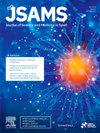优秀残疾人运动员的健康问题——一项53,739个运动员日的前瞻性队列研究。
IF 3
2区 医学
Q1 SPORT SCIENCES
引用次数: 0
摘要
目的:残奥运动员受伤和疾病的纵向数据是有限的。因此,目的是阐明与人口因素和运动暴露有关的健康问题的流行病学在精英残疾人运动员队列中。设计:前瞻性队列研究。方法:邀请所有德国残奥代表队运动员参加本研究。在2019年至2021年期间,通过每周在线问卷(奥斯陆运动创伤研究中心健康问题问卷)监测健康问题。此外,记录每周的主要体育活动、训练暴露和主观训练强度。分析流行病学描述性统计、风险比和优势比。结果:在124 周的观察期内,122名残疾人运动员(48 %为女性;平均年龄:28岁 岁)报告了438个(248个严重的)健康问题,同样与疾病和伤害相关。女性表现出维持严重健康问题的两倍风险(风险比 = 1.8;95 %置信区间:1.2-2.8)。维持严重健康问题的较低风险与超过5 年的精英训练相关(优势比 = 0.9;95 %置信区间:0.8-0.9)。在任何给定的时间,10. %(95% %置信区间:9.6-11.5)的参与者报告了严重的健康问题,并且在比赛的几周内患病率升高(9.8 %;95 %置信区间:4.2-15.4)。在训练营期间,主要报告了新的过度使用损伤(41.2 %),而在比赛期间,急性损伤达到高峰(31.8% %)。正常训练强度的改变与更严重的健康问题相关(比值比范围 = 1.5-4;95 %置信区间 = 1.1-4.8)。结论:监测女运动员,以及那些少于5年的经验是实质性的。健康问题的模式在不同季节有所不同。教练员和医务人员的教育是必要的,以安全指导残疾人运动员。本文章由计算机程序翻译,如有差异,请以英文原文为准。
Health problems in elite Para athletes — A prospective cohort study of 53,739 athlete days
Objectives
Longitudinal data on injury and illnesses in Para athletes is limited. Therefore, the aim was to illustrate the epidemiology of health problems concerning demographic factors and sporting exposure in an elite Para athlete cohort.
Design
Prospective cohort study.
Methods
All German Paralympic squad athletes were invited to participate in this study. Between 2019 and 2021 health problems were monitored via a weekly online questionnaire (Oslo Sports Trauma Research Centre questionnaire on health problems). Additionally, primary sporting activity, training exposure, and subjective training intensity per week were recorded. Epidemiological descriptive statistics, hazard ratios and odds ratios were analysed.
Results
Over an observation period of 124 weeks, 122 Para athletes (48 % females; mean age: 28 years) reported 438 (248 substantial) health problems, equally paired into illnesses and injuries. Females demonstrated a two-fold risk of sustaining a substantial health problem (hazard ratio = 1.8; 95 % confidence interval: 1.2–2.8). A lower risk of sustaining a substantial health problem is associated with more than 5 years of elite training (odds ratio = 0.9; 95 % confidence interval: 0.8–0.9). At any given time, 10.5 % (95 % confidence interval: 9.6–11.5) of the participants reported a substantial health problem and prevalence was elevated during weeks of competition (9.8 %; 95 % confidence interval: 4.2–15.4). During training camps new overuse injuries were mainly reported (41.2 %), whilst acute injuries peaked during competitions (31.8 %). Changes to the normal training intensity were associated with more substantial health problems (odds ratio range = 1.5–4; 95 % confidence interval range = 1.1–4.8).
Conclusions
Monitoring of female athletes, and those with less than five years of experience is substantial. Health problem patterns varied during the season. Education of coaches and medical staff is necessary to safely guide the Para athletes.
求助全文
通过发布文献求助,成功后即可免费获取论文全文。
去求助
来源期刊
CiteScore
7.40
自引率
10.00%
发文量
198
审稿时长
48 days
期刊介绍:
The Journal of Science and Medicine in Sport is the official journal of Sports Medicine Australia (SMA) and is an an international refereed research publication covering all aspects of sport science and medicine.
The Journal considers for publication Original research and Review papers in the sub-disciplines relating generally to the broad sports medicine and sports science fields: sports medicine, sports injury (including injury epidemiology and injury prevention), physiotherapy, podiatry, physical activity and health, sports science, biomechanics, exercise physiology, motor control and learning, sport and exercise psychology, sports nutrition, public health (as relevant to sport and exercise), and rehabilitation and injury management. Manuscripts with an interdisciplinary perspective with specific applications to sport and exercise and its interaction with health will also be considered.

 求助内容:
求助内容: 应助结果提醒方式:
应助结果提醒方式:


